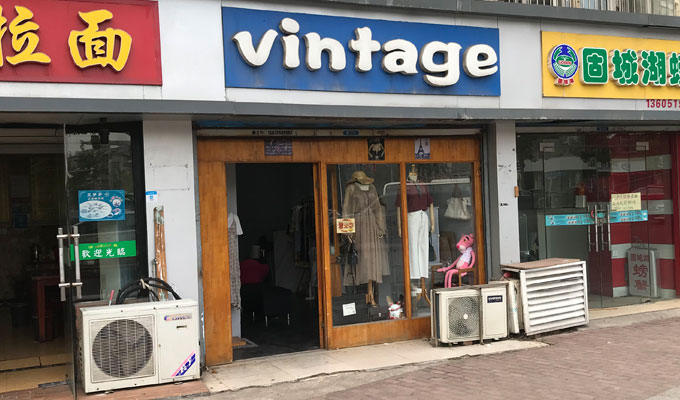The last time I went home, vintage was all the rage. My mother used to take me Op shopping (opportunity), charity or thrift to those Brits and Americans reading this; the smells, the stories, the treasures we could find; it was exciting stuff. It was never really fashionable to actually wear anything we bought; only recently has fashion swung in the direction of wearing second hand clothes.
When it became chic, the word that was mainly used to describe an old whisky or wine was given a whole new identity. Suddenly, “vintage” was all the rage. Not only clothes, but record players from the 60s, even cassette players from the 80s and VCRs from the 90s all suddenly fell under the vintage banner, somewhat prematurely aging a whole generation, might I add!
Vintage; denoting something from the past of high quality, especially something representing the best of its kind. With regards to clothing, Cambridge dictionary defines vintage as, “used but of good quality”. In China it’s “old style” (老式) and the use of the word mirrors the trend that began in the West and is gaining popularity in China.
As a foreigner in China, one can be mistaken for expecting a shop that calls itself Vintage, to actually have vintage clothing in it. “No, everything in here is brand new”, said a shop owner in Gulou who indeed works in a shop that is named thus… in English. “So why is your shop called Vintage? And why does everything look old and dusty”, I asked. “Well, the previous owners sold second hand clothes, and so we just kept the name and the style”.
- Where the Dust Settles; Nanjing’s Vintage Curio Shop
- China’s New Retro Wave; Snacks, Toys and Hanfu
- From Kerosene to LED; 70 Years of Lighting up Nanjing’s Streets
When looking at how the Chinese view vintage clothing, it seems to be a matter of first and second tier internationalisation. The first tierers seem to have let go of some traditional beliefs that surround second hand clothes. They have adopted the trendiness of the practice and seem to be on board with its eco-friendly aspects. Whereas, us second tierers, even though we like the look, we still cannot bare the thought of wearing another person’s hand-me-downs.
Shanghai-based buy and sell clothing company Live with Less hope to educate Chinese people about their throw-away habits, and how it is affecting the environment. Although this is becoming quite trendy in places such as Shanghai’s French quarter, elsewhere in China, superstition trumps the trend.
Traditionally, it is considered bad luck to wear another person’s clothing, especially if that person has died. Not only is it unlucky, but it is also considered beneath a person and shows a lack of wealth. “No such shop like this exists in Nanjing”, said my accountant. While that is not entirely true; Nanjing’s trendiest hood Shanghai Lu does house a collection of “vintage” shops, the attitude says it all.
That my accountant’s screwed up face at the mere thought of paying money for someone else’s trash told me a lot. “Why would I buy old clothes when I can buy brand-new, good-quality clothes on Taobao?”. Good point. I opened the APP and searched vintage in English. Thousands of old styled clothes instantly flooded the screen. Hawaiian shirts and Downtown Abby dresses scroll over 80s overalls and WW2 dresses. Of course, images of Audrey Hepburn, actual handheld telephones and briefcases appear as well; none of it old, all of it new.
It almost negates the noun itself and entirely focuses only on its form as an adjective; actually paying for something old, well that’s just not cricket. Granted, charity shopping is a skill and takes a lot of sifting through some truly atrocious stuff before anything of value appears. Perhaps the luxury of passing down antiques died with the Cultural Revolution. How many Chinese people out there keep the tradition of family heirlooms going?
- Nanjing’s Former Embassies; Reliving Republican Glamour
- Speakeasy Alive & Well in Nanjing Factory
- Retro is Red; Vintage is in
Recently, Xi Jinping’s government cracked down on the buying of “foreign rubbish”. Trendy Beijing and Shanghai shops now find themselves in a catch 22 situation. As the Chinese do not have the facilities to properly dispose of their clothes, and it is not culturally acceptable to give clothes away, shop owners buy from the US or Japan.
However with China’s recent crackdown, some authorities deem the clothes sold in their shops as “foreign garbage”, and as a result many shops simply lie and say their clothes are new. “Many people in China still regard these clothes as ‘foreign trash’, which is damaging to the development of vintage culture… It can’t be understood by everybody. People just have different lifestyles”, says Vintage shop owner Eliza Zhao, originally reported by That’s Beijing.
Just as the popularity of vintage wine exploded in China, so too will the vintage scene. The youth of today’s China see things differently. They have less need to worry about money, nor do they feel chained to ancient beliefs about face. An appreciation for real quality and substance is emerging from a generation that has the luxury of enjoying the finer things in life; a world away from their grandparents or even parents.
China’s youth may contradict itself, can’t make up its mind and might battle with the real value of face. If indeed the clothes on their backs in the WeChat selfies they share are real vintage, the truth behind why they bought them and whether they are real or not may only be understood by their children and their grandchildren to come.









